
Michael Hieslmair/ Michael Zinganel
Ausstellungsbeitrag für Islands & Ghettos kuratiert von Johan Holten für den Kunstverein Heidelberg, 2008; Überarbeitet für die NGBK Berlin und das Stadtmuseum Graz, 2009
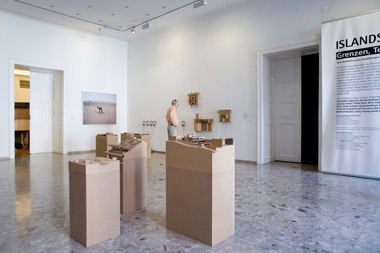
Vergleichende sozialräumliche Modell- und Audioinstallation zu den Städten Dubai, Caracas und Heidelberg / Berlin
Der Ausstellungsbeitrag besteht aus 3 Modellgruppen für die Städte Dubai, Caracas und Heidelberg / Berlin. Jede der Modellgruppen besteht wiederum aus drei einzelnen Architektur- und Stadtmodellen aus Wellkarton auf einem Sockel aus MDF-Platten, einem abstrahierten Wegenetzdiagramm aus Acrylstäben sowie begleitenden Audiospuren.
Die Modelle zeigen jeweils typische Wohnhäuser wohlhabender deutscher Expat-Familien Dubai und Caracas, sowie einem Expat aus Venezuela in Heidelberg (bzw. der Geschäftsführerin einer Expat Agentur in Berlin). Sie zeigen aber auch die typischen Wohnviertel ihrer DienstleisterInnen, die selbst über einen migrantischen Hintergrund verfügen, sowie den Wohn- und Arbeitsort, über den die Expats und ihre DienstleisterInnen miteinander in Beziehung treten.
Dabei wird nicht nur die räumliche Verinselungstendenz unterschiedlicher sozialer Milieus thematisiert, sondern vor allem auch auf die Notwendigkeit der Passage zwischen den abgeschottet erscheinenden Inseln hingewiesen. Denn durch die Überschreitung der Grenzen und durch die Fahrt von einem Ghetto in ein mitunter weit entferntes anderes werden die überlebensnotwendige Erwerbsarbeit oder ein dem angestrebten Milieu- und Status angepasster Lebensstil erst ermöglicht.
Daher stehen täglichen Wege der Expats und ihrer DienstleisterInnen im Zentrum der Arbeit. Ihnen sind auch einzelne Kopfhörer zugewiesen, auf denen Nachrichtensprecher den jeweiligen Tagesablauf aus den unterschiedlichen Blickwinkeln der Akteure protokollarisch nacherzählen.
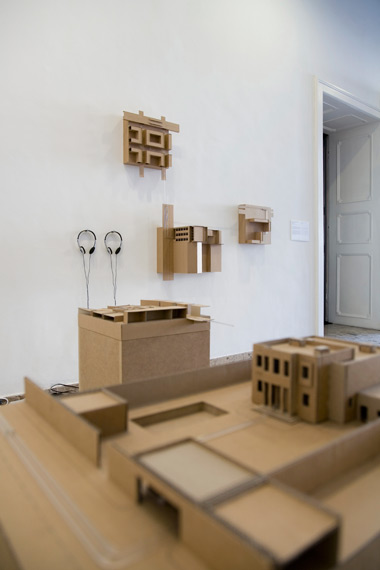
Recherchen
Die Autoren verzichteten bewusst auf die angebotene kurze Recherche-Reise in die ‚Inseln und Ghettos’ von Dubai und Caracas. Die Recherche zu dieser Arbeit basiert daher nicht auf Vor-Ort Interviews mit Akteuren unterschiedlicher sozialer Milieus und Ethnien in Dubai oder Caracas. Stattdessen versuchten die Autoren das darzustellende sozialräumliche Beziehungsgefüge über sozial und geographisch ‚näher stehende’ Akteure zu erschließen: nämlich über vergleichsweise wohlhabende und gebildete deutsche Expat-Familien in deren Quellregion Deutschland, die sich bewusst oder unbewusst an den Verinselungstendenzen mitbeteiligen, bzw. über in Deutschland lebende Expats, die auch hier auf durchaus vertraute Verinselungen treffen.
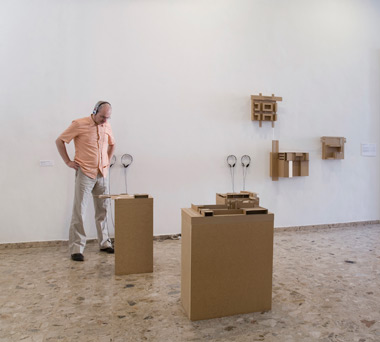
Die durchaus auch reflektierenden Erfahrungsberichte dieser Akteure ermöglichten zumindest eingeschränkte Einblicke ihr Leben und das ihrer DienstleisterInnen. So zeigt sich im Falle von Dubai, dass die Geschlechtertrennung die Segregation sozialer Milieus bei weitem übertrifft und sowohl für nichtmuslimische Frauen (und Männer) aus dem wohlhabenden Expat- als auch dem armen DienstleisterInnenmilieu die Verinselung schlechthin darstellt.
Die Architektur- und Stadtmodelle der Wohnhäuser und Arbeitstätten wurden auf Basis von Fotos, Beschreibungen und Adressangaben vor allem aber über Luftaufnahmen aus Google Earth rekonstruiert.
SprecherInnen: Nicole Dietrich, Ulla Ebner, Herbert Gnauer und Peter Waldenberger; Bettina Allmoda, Ralf Homann (Adaptionen für Berlin)
Fotos Stadtmuseum Graz: Martin Grabner
Fotos Kunstverein Heidelberg: Hieslmair/ Zinganel
Architekturmodelle und Tonspuren zu folgenden Akteuren
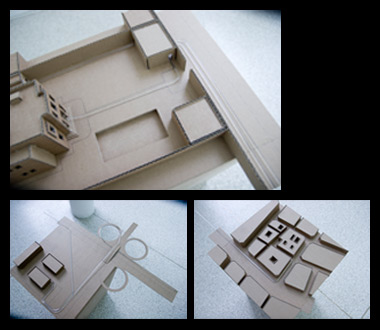
DUBAI – Manager eines deutschen Unternehmens in Dubai; einer seiner Mitarbeiter aus Indien, der in Alt-Dubai wohnt; die deutsche Ehe-Frau und das Hausmädchen aus Sri Lanka
Norbert K.
[audio:http://hieslmair.mur.at/website/audio/crossing_gates/01 Dubai_Norbert K.mp3]
Sabina K.
[audio:http://hieslmair.mur.at/website/audio/crossing_gates/02 Dubai_Sabina K.mp3]
Sakthipriyah M.
[audio:http://hieslmair.mur.at/website/audio/crossing_gates/03 Dubai_Sakthipriyah M.mp3]
Mansukh G.
[audio:http://hieslmair.mur.at/website/audio/crossing_gates/04 Dubai_Mansukh G.mp3]
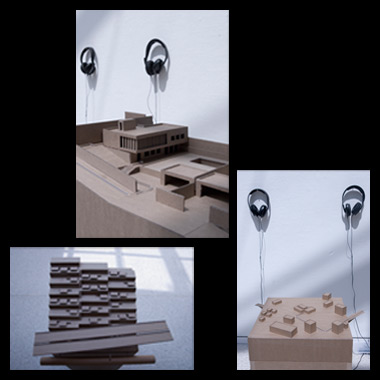
CARACAS – Leiter des Goethe Institutes in Caracas; ein Hausmädchen aus Kolumbien, das in einem Barrio lebt
Johannes M.
[audio:http://hieslmair.mur.at/website/audio/crossing_gates/05 Caracas_Johannes M.mp3]
Carmina A.
[audio:http://hieslmair.mur.at/website/audio/crossing_gates/06 Caracas_Carmina A.mp3]
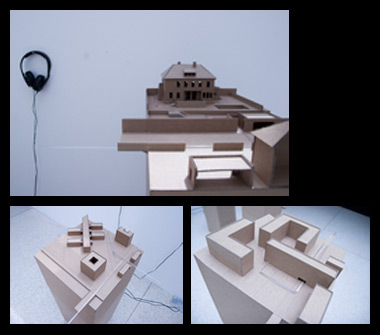
HEIDELBERG – Wissenschafterin aus Venezuela an der Universität Heidelberg; ein Mann des Wachdienstes auf dem Uni-Campus, der in einem sozialen Wohnbau am Stadtrand lebt
Consuelo
[audio:http://hieslmair.mur.at/website/audio/crossing_gates/07 Heidelberg_Consuelo.mp3]
Kevin L.
[audio:http://hieslmair.mur.at/website/audio/crossing_gates/08 Heidelberg_Kevin L.mp3]
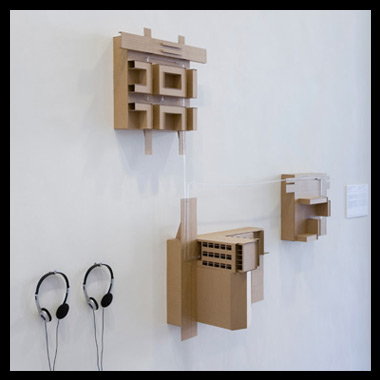
BERLIN – Geschäftsführerin einer Relocation Agentur, die vorwiegend Expats in Berlin betreut und mit ihrer Familie am Prenzlauer Berg lebt; ein Doorman der in Berlin Marzahn wohnt
Lan H.
[audio:http://hieslmair.mur.at/website/audio/crossing_gates/09 Berlin_Lan H.mp3]
Frank K.
[audio:http://hieslmair.mur.at/website/audio/crossing_gates/10 Berlin_Frank K.mp3]
Kunstverein Heidelberg
Stadtmuseum Graz
Comparative socio-spatial model and audio installation on the cities of Dubai, Caracas and Heidelberg/ Berlin
Contribution to the exhibition Islands & Ghettos curated by Johan Holten for Kunstverein Heidelberg, 2008; adapted for NGBK Berlin and Stadtmuseum Graz, 2009
The contribution to the exhibition consists of three groups of models for the cities of Dubai, Caracas and Heidelberg / Berlin. Each of the groups of models consists in turn of three separate corrugated-card architectural and urban models on a base of MDF panels, an abstracted path network diagram of acrylic rods, and accompanying sound-tracks.
The models each present typical houses of wealthy German expat families in Dubai and Caracas and of an expat from Venezuela in Heidelberg (and the manageress of an expat agency in Berlin). But they also show the typical residential areas of their service providers, who also have a migrant background, and the home / place of work where the expats and service providers come into contact with each other.
The project focuses not only on the tendency towards physical islandisation of various social milieux, but above all on the necessity of crossing between the seemingly insular areas. For crossing the boundaries and travelling from one ghetto to another, possibly distant, ghetto, is prerequisite to securing vital gainful employment or to achieving a lifestyle commensurate with the desired milieu and status. Which is why the daily travel of expats and their service providers is a central factor of work. These paths are each assigned headphones with which people can listen to news-readers recounting the daily routine from the different perspectives of the actors.
Research: The authors deliberately refrained from embarking on the short research trip to the ‘Islands and Ghettos’ of Dubai and Caracas that was offered to them. The research for this work is thus not based on interviews on site with actors from different milieux and ethnic groups in Dubai or Caracas. Instead, the authors attempted to examine the socio-spatial system of interrelations by means of socially and geographically ‘closer’ actors: that is to say, by means of comparably wealthy and educated German expat families in their origin region Germany, who, consciously or subconsciously, take part in the tendencies towards islandisation, and by means of expats living in Germany, who also find familiar insular areas there.
The reports given by these actors, often very reflectively, made it possible to gain an at least limited insight into their lives and those of their service providers. In Dubai, for example, it was found that gender segregation by far exceeds segregation of social milieux and is the foremost islandisation factor for both non-Muslim women (and men) from the wealthy expat milieu and from the poor service provider milieu. The architectural and urban models of the homes and places of work were reconstructed on the basis of photos, descriptions and addresses, but above all with the aid of aerial photos taken from Google Earth.
Speakers: Nicole Dietrich, Ulla Ebner, Herbert Gnauer and Peter Waldenberger; Bettina Allmoda, Ralf Homann (adaptations for Berlin)
Architectural models and sound-tracks for the following actors:
DUBAI – a manager of a German company in Dubai; one of his employees from India who lives in Old Dubai; the German wife and the maid from Sri Lanka
CARACAS – the head of the Goethe Institute in Caracas; a maid from Colombia who lives in a barrio
HEIDELBERG – a scientist from Venezuela at the University of Heidelberg; a man from the campus security service who lives on a council estate on the outskirts of the city
BERLIN – a manager of a relocation agency who mainly looks after expats in Berlin and who lives with her family in Prenzlauer Berg; a doorman who lives in Berlin Marzahn